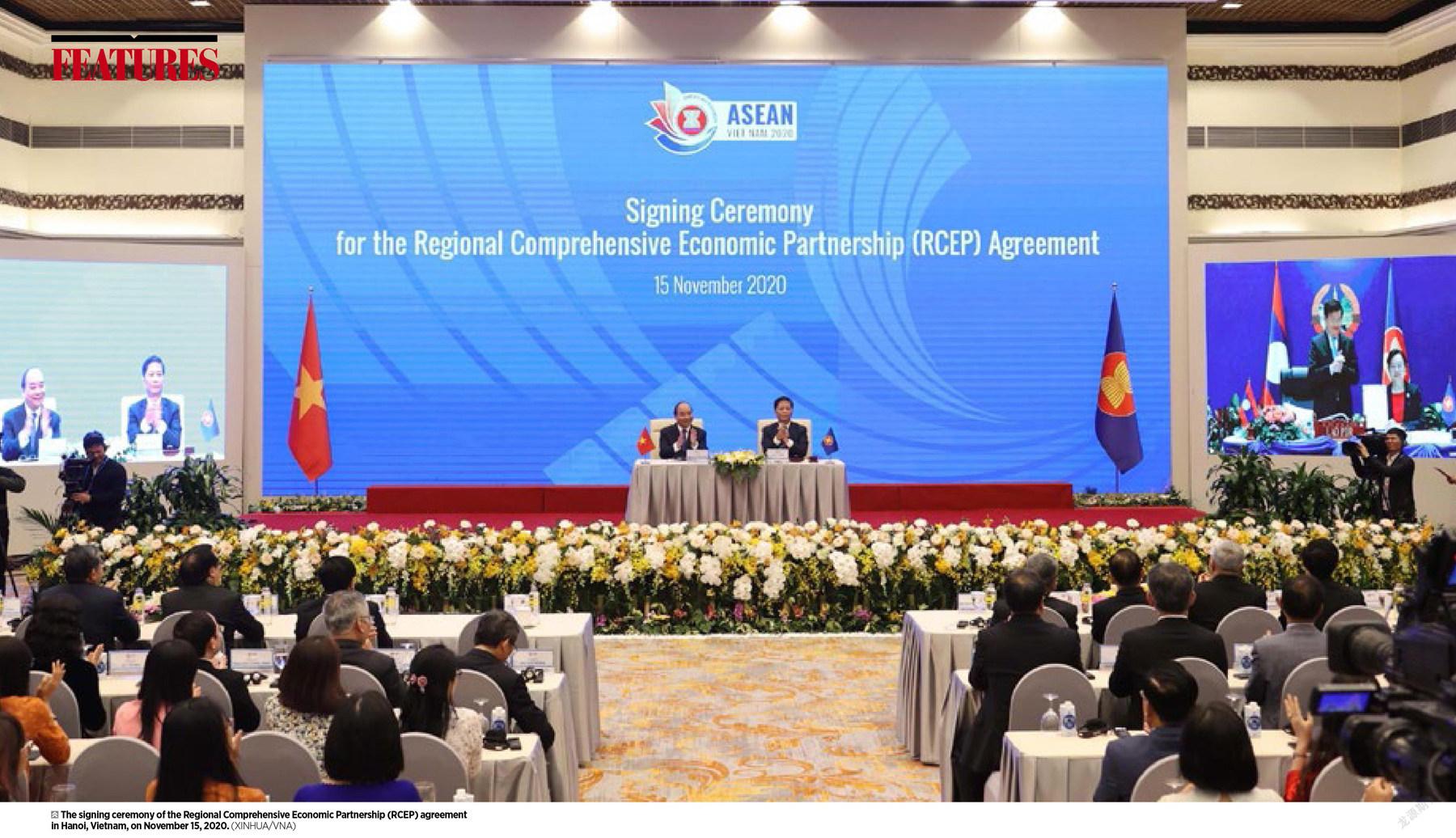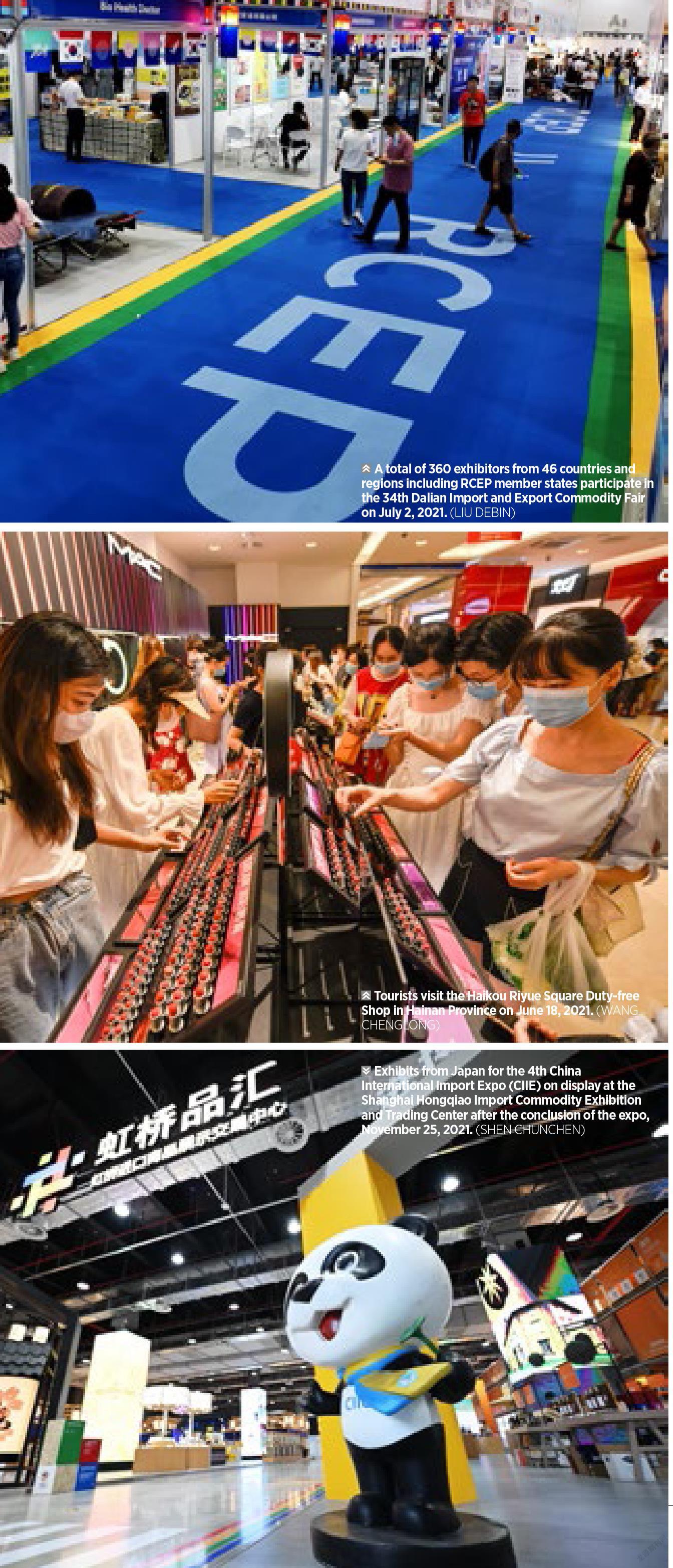DAWN OF THEASIAN CENTURY
2022-06-26YuanYananZhangYan
Yuan Yanan Zhang Yan




The first rays of the sun in 2022 will likely welcome the advent of the Asian Century.
In recent decades, economists have often discussed how long it will take for the Asian Century to arrive. On January 1, 2022, the RCEP agreement entered into force. As the largest free trade agreement covering 30 percent of the world’s total population and trade, it will likely mark an important turning point for the center of gravity of the world economy as it shifts from Europe and the Americas to the East.
The most common indicator of the Asian Century that economists have noted is that Asia’s share of global GDP will rise to 50 percent or more. Ten years ago, the Asian Development Bank (ADB) predicted in its report Asia 2050: Realizing the Asian Centurythat Asia could, by 2050, account for more than half of global GDP, trade, and investment, and enjoy widespread affluence. McKinsey Global Institute (MGI) declared in a 2019 report that Asia’s share of global trade, capital, personnel, knowledge, transportation, culture and resources has been increasing as it heads for the Asian Century. MGI predicted that by 2040, Asia’s share of global GDP will rise to 50 percent or more, and its share of global consumption will rise to 40 percent or more, 10 years earlier than what the ADB predicted.
In the 18th and 19th centuries, Europe achieved its economic rise with the Industrial Revolution. The United States became the global hegemon after two world wars. In contrast, from 1750 to 1990, Asia’s share of global GDP declined all the way from 60 to 20 percent. Since the 1990s, the dividends of globalization have helped Asia gradually reach the road to rejuvenation. Asia’s share of global GDP gradually recovered to 27 percent in 2010, and has been maintaining good momentum of growth.
Many economists believe Asia will regain a dominant global economic position in the 21st Century. According to late economic historian Angus Maddison, Asia accounted for more thanhalf of the world’s economicoutput for nearly 18 centuriesof the last 20 centuries. Hepredicted the Asian Centurywould simply be a “restoration” of its economic leadership.
The core proponents ofRCEP are ASEAN and East Asianeconomies represented byChina, Japan, and South Korea.The signing of the agreementunderscores the ambitions ofAsian countries to expand theirglobal economic landscape. “This reflects both the economic rise of major Asian countries and Asia’s change in identity,” opined ZhaiKun, vice president of PekingUniversity’s Institute of AreaStudies. “Asia’s role has changedfrom being passively embeddedin the world economy to actively leading world development.The entry into force of RCEP willmark the beginning of the AsianCentury.”
The ADB report also noted that although restraints on economic integration remain, trade inAsia is increasingly open on thewhole. Regional cooperationand economic integration,as well as barrier-free flow oftrade and investment acrossAsia, are important strategiesto achieve the Asian Century.As an important institutionalarrangement for regionalcooperation and integration,RCEP will help Asia fend offexternal shock and promotetrade and investment facilitation, which will be conducive to thefree flow of labor force whilelaying the foundation for shaping a unified and open Asian market, reducing regional developmentimbalance, and further drivingcomprehensive cooperation inAsia.
Shaping a Big Unified Market
RCEP has completedintegration of rules andstandards, which will upgraderegional integration. “Overtime, various bilateral freetrade agreements haveemerged in Northeast Asiaand Southeast Asia,” said YuanChunqiang, deputy directorof the Department of WorldEconomics at the China Institute of Contemporary InternationalRelations. “But there hasn’tyet been a comprehensivefree trade framework, so ruleshave been fragmented, leavingevery regional economy on itsown.” The signing of the RCEPagreement enables regionaleconomies at different levelsof development to integratetheir advantages in resources,technology, manpower, andmarket under unified rules, so as to tap their respective strengthfor mutual benefits and further expand the free trade network.
The RCEP agreement contains 20 chapters covering intellectual property rights, e-commerce,market competition, government procurement, and many otherissues. RCEP has also reachedconsensus on small andmedium-sized enterprises andeconomic and technologicalcooperation, beyond the scope of WTO rules.
In terms of trade liberalization, more than 90 percent of trade ingoods in the region will gradually achieve zero tariffs, 65 percentof the service industry will open,and foreign equity restrictions will be relaxed. In terms ofinvestment, trade barrierswill be further eliminated,business requirements such as local component proportionor technology transfer asmarket access conditions willbe prohibited, and relevantprocedures will be simplifiedto promote growth of regional investment.
“By implementing higherlevels of trade and investmentliberalization and facilitationmeasures than the WTO,the world’s largest regionalintegrated market will graduallyemerge,” said Yuan Bo, deputydirector of the Asia Instituteat the Chinese Academyof International Trade andEconomic Cooperation (CAITEC). It will not only help to expandinternal regional trade andinvestment, but also attractmore foreign capital to promoteregional economic growth.
According to CAITEC’scalculations, by 2035, the RCEPwill boost the region’s real GDP by 0.86 percent, exports by 18.3 percent, and imports by 9.63percent, while lifting global real GDP by 0.12 percent and globalforeign trade by 2.91 percent.The entry into force of the RCEP agreement will undoubtedlyaccelerate the shift of center ofgravity of the world economyeastward, which is certainlygood news for Asian and global economic recovery from thepandemic.
“The continuous economicdevelopment of East Asia andgradual upgrading of Asianregional cooperation willeventually lift Asia to stand toe- to-toe with North America and the EU, laying a foundation forthe world economy to developon an equal footing,” said Yuan Chunqiang. “That will be ofepoch-making significance.”
Promoting Free Flow of Economic Factors
As member states significantly reduce restrictions on trade and investment, the flow of economic factors such as capital, labor, and technology will be smoother in the RCEP region, which will help to deepen the division of labor and cooperation within the region and improve production efficiency.
The RCEP has adopted the cumulative rules of origin, stipulating that only 40 percent of regional value content is required for goods to be considered of RCEP origin, much lower than the threshold of other free trade agreements. Once a company obtains the certificate of origin, it is eligible for preferential tariff treatment. The rules will not only significantly reduce the trade cost ofenterprises and improve the actual utilization of preferential tax rates, but will also greatly promote the circulation and optimal allocation of production factors, which is conducive to forging stronger industrial chains.
According to a reportreleased by German financialinstitution Allianz Group, theRCEP rules of origin will helpto remove non-tariff barriersand reduce transaction costs.The report estimated thatimplementation of the rules oforigin would generate US$90billion in annual trade growthfor the RCEP region. Expertsfrom the ADB and UNCTADjointly published an articlethat deemed it an impressivearrangement and explained thatfull implementation of RCEPcommitments will ensure tradeacross the entire value chain will not be subject to tariffs if it complies with rules of origin and relevant procedures. The essay suggested that implementation of these rules will be directly related to the success or failure of RCEP.
Including China, Japan, and South Korea in the same free trade zone is a historic breakthrough propelling regional economic integration in East Asia to take an important step forward. Within the RCEP framework, China, Japan and South Korea are establishing free trade zone relations for the first time. Previously, geopolitical conflicts, historical disagreement, territorial disputes, and other issues caused the three countries to suffer continuous setbacks in free trade agreement negotiations,resulting in an integration agreement never being reached. The signing of the RCEP agreement has laid the foundation for the realization of a China-JapanSouth Korea Free Trade Zone.
China, Japan, and South Korea are important economies in the Asia-Pacific region. Their inclusion in the unified free trade zone will accelerate integration of regional value chains and invigorate the regional economy. In terms of China-Japan trade, China will grant zero-tariff treatment to 86 percent of taxable items from Japan, as compared to 8 percent previously. Meanwhile, Japan will exempt tariffs on 86 percent of taxable items from China. In terms of Japan-South Korea trade, Japan will exempt tariffs on 92 percent of taxable items from South Korea, as compared with a previous 19 percent. These changes will be a great impetus for trade in East Asia.
The Economic Research Institute for ASEAN and East Asia (ERIA), a think tank based in Jakarta, Indonesia, predicted that the RCEP’s inclusion of China, Japan, and South Korean would trigger a “CJK effect” causing more goods, services, and investment from the three countries to flow into ASEAN countries and promote the economic and social development of Southeast Asia.
“Southeast Asian countries are now more accustomed to small economic circles within the region,” commented KiyoyukiSeguchi, research director at the Canon Institute for Global Studies. “The RCEP agreement will bring more opportunities for Southeast Asian enterprises to integrate with Japan, China, and South Korea to boost development.”
PouSothirak, executive president of the Cambodian Institute of Cooperation and Peace, said that the RCEP agreement taking effect would create benefits from technology transfers from stronger countries, freer trade in goods, and closer peopleto-people exchanges. Southeast Asian countries are expected to achieve annual growth of US$19 billion by 2030. Advanced production technology and human capital will converge in East Asia, and RCEP will accelerate the arrival of the “Asian Century.”
Reducing Imbalances in Regional Development
The ADB report noted that outsourcing pieces of the industrial chain originating in Europe and East Asia has provided new jobs and value-added space for low-income economies and achieved greater flow of goods and services.
RCEP members have a large development gap. The agreement includes both highly developed countries, such as Japan, Australia and Singapore, and underdeveloped countries such as Laos, Cambodia and Myanmar. From this perspective, the RCEP is more flexible and broader than agreementsdominated by developed countries, achieving unityof quality and inclusiveness. The agreement doesnot contain provisions susceptible to controversysuch as state-owned enterprises, labor standards, orenvironmental standards. Instead, its flexibility andconsultation mechanisms enable member states toseek a better position in the industrial chain suitablefor their unique advantages.
“It’s a challenging task to get the 15 partnerstogether to negotiate high-level free trade rules thatare fairly comprehensive and fulfilling,” commentedCai Qiang, director-general of the Tariff Departmentat the Chinese Ministry of Finance. The RCEP memberstates vary greatly in the level of development, naturalresources, and economic structure. But this diversityis also an advantage that helps to solve problemsranging from financing to raw materials, production,and sales within the RCEP region, which is conduciveto the industrial upgrading and optimization in theregion.
Ong Tee Keat, former deputy speaker of the Houseof Commons of the Malaysian Parliament andchairman of the Malaysian think tank Centre forNew Inclusive Asia, opined that RCEP preferencesfor its member states would help underdevelopedcountries attract more investment. “Look at Myanmarand Laos, two member states which will leave theranks of underdeveloped countries in the comingyears,” Ong said. “Although they will soon lose EU andNorth America trade preferences for underdevelopedcountries, implementation of RCEP will bring newopportunities to the two countries that will likely beenough to offset the impact of the former on theireconomy.”
According to a CAITEC forecast, in terms of realGDP growth rate, ASEAN countries will benefit most.By 2035, ASEAN’s overall cumulative GDP growth rateis expected to increase by 4.47 percent because ofRCEP. The cumulative imports and exports of ASEANmember states such as the Philippines, Cambodia,Thailand and Vietnam are expected to increase bymore than 20 percent. RCEP will create more jobsfor ASEAN countries and improve the wage levels ofunskilled and skilled labor in these countries. RCEPwill also drive regional investment growth, raisethe cost of capital in most ASEAN member states,and increase returns on investment in Cambodia, Thailand, Malaysia,Singapore and Indonesia, which will further narrow the development gap between the member states in theregion.
The COVID-19 pandemic has exerted a profound impact on the Asia-Pacificregion. The digital economy is expected to be a driver of economic recovery.Following global development trends,RCEP has promoted digital trade andthe digital economy by eliminatingtariff barriers, developing e-commerce, improving trade facilitation, andawarding preferences to small andmedium-sized enterprises andtechnical cooperation.
“Among the RCEP member states,China, Japan, South Korea andSingapore are in leading positionsin digitization at the global level,while some ASEAN countries suchas Myanmar, Cambodia and Laosare lagging behind,” commentedWang Ruibin, deputy director of theDepartment for World Economics and Development at the China Instituteof International Studies. “RCEP
will support universal and equalparticipation of its members in thedigital economy, help to bridge thedigital gap between ASEAN member states, and steadily transform theeconomy through digitization.”
Challenges and Opportunities
Many have great expectations forthe RCEP’s role in tapping economicpotential and promoting economicintegration in Asia. At the same time, however, the regional free tradeagreement will face many challenges.
The aforementioned ADB reportmentioned that Asia’s economic take-off is not necessarily inevitable, noris the Asian Century. Imbalances andinequality in regional development, the middle-income trap, global warming,and other factors may all lead to slower economic growth.
RCEP covers a wide area and hasvast differences among member states in the level of development, cultureand ethnicity. Some of the membersalso have historical, religious andterritorial disputes within the region.All these could cause uncertainty forimplementation of the agreement.
ZhaiKun noted that disputesamong states are not conduciveto the construction of an externalenvironment for economicperformance, which will ultimately affect the common interests of allin the region. But all transnationaleconomic and trade agreements
face similar problems. “We need toeffectively mitigate risks by focusing on specifics rather than allowing specificdifficulties to get in the way of overalldevelopment,” he said.
PouSothirak predicted that the RCEP would cause further opening of themarket, which could lead to externalshocks to emerging industries in some countries and a rising trade deficit. The Centre for Indonesian Policy Studies(CIPS) made a similar point in itsNovember 2020 policy analysis report. It also noted that Indonesia would seeeconomic growth after joining RCEP,while withdrawing would lead to adrop of its GDP by 0.07 percent. So,participation in RCEP was the onlyrational choice. The government wasmotivated to formulate policies toimprove industrial competitivenessand production efficiency andconstantly upgrade the industrialstructure to better benefit fromparticipation.
Full implementation of theagreement is also facing challenges.Cyn-Young Park, an economist withthe ADB’s Department of EconomicResearch and Regional Cooperation,said that since some RCEP membershad already concluded 10+1 free tradeagreements with ASEAN, the benefits of liberalization could be limited initially, meaning that there is little incentivefor the member states to implementthe RCEP agreement immediately.However, the RCEP Secretariat andother relevant bodies will closelymonitor the implementation ofthe agreement, and RCEP’s openarchitecture will attract new membersin the future. RCEP will serve as acatalyst for strengthening regionalcooperation.
In order for businesses to benefitmore from the provisions of theRCEP agreement, Yuan Bo suggestedgovernments strengthen outreach and raise awareness to help businessesunderstand and take advantage of the agreement. “The entry into force ofRCEP will encourage more enterprises to invest in the member states, buta lack of knowledge of the laws andregulations in many host countries will be a constraint on investment,” saidYuan.
At a State Council policy briefingon December 30, 2021, Chinese ViceMinister of Commerce Ren Hongbinsaid that China has completed domestic preparations for implementing theRCEP agreement and is ready to fulfill a total of 701 binding obligations underthe agreement.
Ren also said that implementation of the agreement marks a new milestonefor China’s opening-up.
RCEP has laid an institutionalfoundation for high-level regionalcooperation and economic integration, providing sustained and strongimpetus for the prosperity anddevelopment of the Asia-Pacific region and ensuring Asia’s share of global GDP will rise to 50 percent or more as soonas possible.
RCEP is likely to mark the dawn of the Asian Century. The people of Asia are holding their breath.
